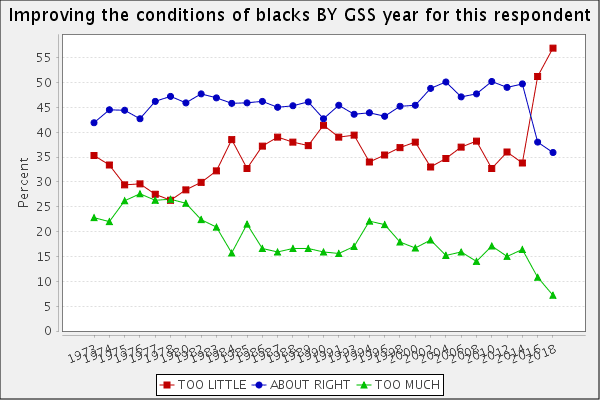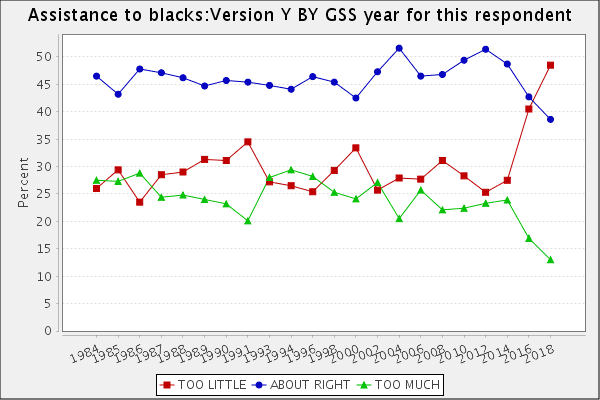Elin Waring writes:
Have you been following the release of GSS results this year? I had been vaguely aware that there was reporting on a few items but then I happened to run the natrace and natracey variables (I use these in my class to look at question wording), they are from the are we spending too much/too little/about the right amont on “Improving the conditions of blacks” and “aid to blacks” (the images are from the SDA website at Berkeley):
Much as I [Waring] would love to believe that the American public really has changed racial attitudes, I find such a huge shift over such a short time very unlikely given what we know about stability of attitudes. And I even broke it down by age and there was a shift for all the age groups.
Then I saw this, and a colleague mentioned to me that the results for proportion not sexually active were strange. And then today people talking about the increase in the proportion not religiously affiliated.
It just seems very odd to me and I wondered if you had noticed it too. Could it be they just hit a strange cluster in their sampling? Or a weighting error of some kind? It’s true that attitudes on gay marriage changed very fast and that seems real, but this seems so surprising across so many separate issues.
I wasn’t sure so I passed this along to David Weakliem, my go-to guy when it comes to making sense of surveys and public opinion. Weakliem responded with some preliminary thoughts:
It did seem hard to believe at first. But there was a big move from 2014 to 2016 too (bigger than 2016-8), so if there is a problem with the survey it’s not just with 2018. The GSS also has a general question about whether the government has a special obligation to help blacks vs. no special treatment, and that also showed large moves in a liberal direction from 2014-6 and again from 2016-8. Finally, I looked for relevant questions from other surveys. There are some about how much discrimination there is. In 2013 and 2014, 19% and then 17% said there was a lot of discrimination against “African Americans” but in 2015 it was 36%; in 2016 and 2017 the question referred to “blacks” and 40% said there was a lot. So it seems that there really has been a substantial change in opinions about race since 2014. As far as why, I would guess that the media coverage and videos of police mistreatment of blacks had an impact—they made people think there really is a problem.
To which Waring replied:
The one thing I’d say in response to David is that while he could be right, these are shifts across a number of the long term variables not just the racial attitudes. Also I think that GSS is intentionally designed to not be so responsive to day to day fluctuations based on the latest news. And POLHITOK sees an increase in “no” responses in 2018 but not so dramatic and it looks like it’s in the same general territory as others from 2006 forward.
What really made me look at those particular variables was all the recent talk about reparations for slavery.
I also saw that Jay Livingston, who I wish had his own column in the New York Times—I’d rather see a sociologist’s writing about sociology, than an ignorant former reporter’s writing about sociology—wrote something recently on survey attitudes regarding racial equality, but using a different data source:
Just last week, Pew published a report (here) about race in the US. Among many other things, it asked respondents about the “major” reasons that Black people “have a harder time getting ahead.” As expected, Whites were more likely to point to cultural/personal factors, Blacks to structural ones. But compared with a similar survey Pew did just three years ago, it looks like everyone is becoming more woke. . . .
For “racial discrimination,” Black-White difference remains large. But in both groups, the percentage citing it as a major cause increases – by 14 points among Blacks, by nearly 20 points among Whites. The percent identifying access to good schools as an important factor have not changed so much, increasing slightly among both Blacks and Whites.
More curious are the responses about jobs. In 2013, far more Whites than Blacks said that the lack of jobs was a major factor. In the intervening three years, jobs as a reason for not getting ahead became more salient among Blacks, less so among Whites.
At the same time, “culture of poverty” explanations became less popular.
Livingston continues with some GSS data and then concludes:
If both Whites and Blacks are paying more attention to racial discrimination and less to personal-cultural factors, if everyone is more woke, how does this square with the widely held perception that in the era of Trump, racism is on the rise. (In the Pew survey, 56% over all and 49% of Whites said Trump has made race relations worse. In no group, even self-identified conservatives, does anything coming even close to a majority say that Trump has made race relations better.)
The data here points to a more complex view of recent history. The nastiest of the racists may have felt freer to express themselves in word and deed. And when they do, they make the news. Hence the widespread perception that race relations have deteriorated. But surveys can tell us what we don’t see on the news and Twitter. And in this case what they tell us is that the overall trend among Whites has been towards more liberal views on the causes of race differences in who gets ahead.
Interesting. Also an increasing proportion of Americans are neither white nor black. So lots going on here.
P.S. Livingston adds:
I also noticed something when I was checking the GSS data that Tristan Bridges posted about LGB self-identification. For those variables (and maybe others—I haven’t looked), the GSS 2014 sample was much larger than in other years before and since, and the 2018 sample smaller. That shouldn’t affect the actual percents, but with fairly rare responses like identifying as gay, the sample size did make me pause to wonder. With larger-n attitude items it shouldn’t matter.
I followed the link to Bridges’s blog, which had lots of interesting stuff, including this post from 2016, Why Popular Boy Names are More Popular than Popular Girl Names, which featured this familiar-looking graph:
Why did this graph look so familiar?? Because I plotted the exact same data in 2013:
I assume that Bridges just independently came up with the same idea that I had—these are public data, and counting the top 10 names is a pretty obvious thing to do, I guess. It was just funny to come across this graph again, in an unexpected place.







Hi,
I saw your blog highly recommended (anecdotally) in a book review. I am a clinical social worker and teach basic psych courses and I am really interested in getting a better grasp on being able to accurately understand studies and apply critical thinking to them.
Where do you recommend I start reading from on your site?
Thanks so much for your help
Alex
If these changes are indeed occurring, some possible explanations come to mind. One is White vs. White struggle. Internecine strife can be the most virulent. In recent years Whites who thought that racial prejudice in the US had largely been overcome have seen in the news evidence that that is not so. They have seen people like them, other Whites, not only behaving badly but horribly so. In rolling back the protections of the voting rights act, the Supreme Court said that the US was a post racist society. Immediately state legislatures began proving them wrong. Whites saw a White governor wagging her finger in President Obama’s face on the tarmac, something that they knew she would never do to a President who was White, and other racist backlash against Obama. Even Whites who might have disagreed with the Black Live Matter movement saw young Black men being killed by police for no apparent reason other than racism. With the advent of Trump they saw a presidential candidate spewing not unobvious appeals to racism, which were lapped up by his racist supporters, people they had not seen before, or at least, in recent years. They saw racist rallies and racially motivated killings. And these White racists were no small part of getting Trump elected. Trump continues his race baiting. To be sure, many Whites’ eyes were opened to the depth and degree of racial hatred in the US, and have become motivated to ameliorate the conditions that Black people live under. But part of their motivation probably is this: We have to do something about these other White people!
Augh. I didn’t realize you followed the name trend as well. Why did you choose top ten? It could be twenty, five, anything? Good for you. I think the trend lines crossed last year. Excited to see the 2018 data. I’ll link to your initial post if I write anything on it. :)
I also updated the post to link to your original post on my blog, giving you credit for the figure initially. Apologies for not having discovered it in 2016. Thanks for your work.
Tristan:
No apology needed. These are public data and we just both happened to make the same graph!
One thing I did do was explore the different ways that GSS offers to do weighting and they didn’t make any substantial difference. There are some small changes in regional distributions over the last 3-4 waves (e.g. New England is up by a few points) but to me these don’t look like enough to account for the change. So maybe it is real.